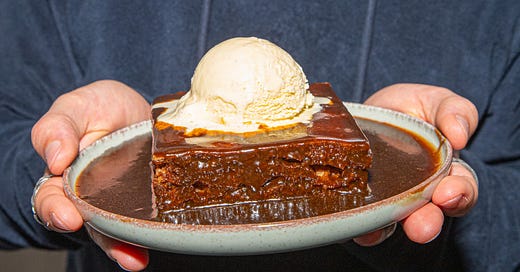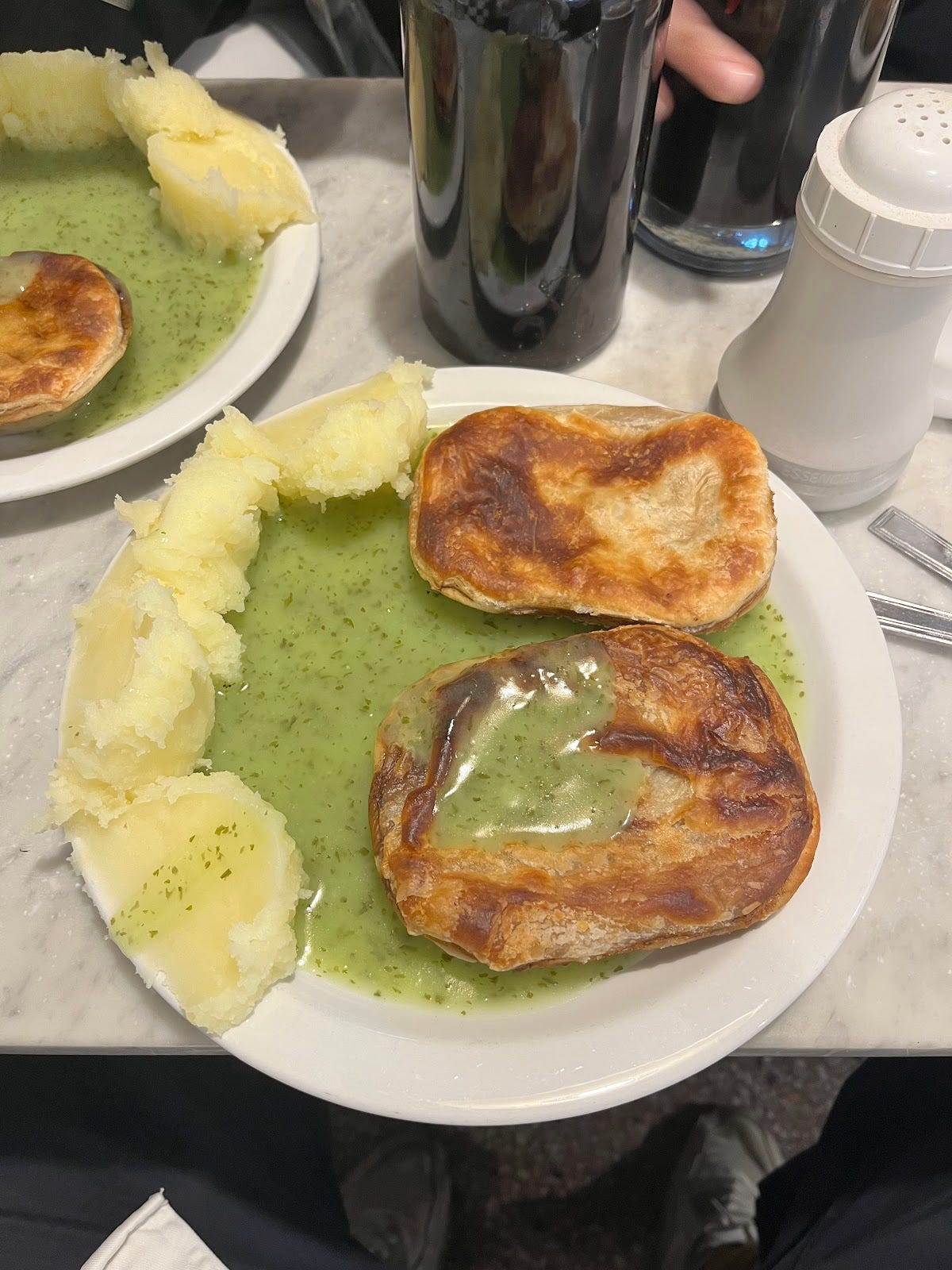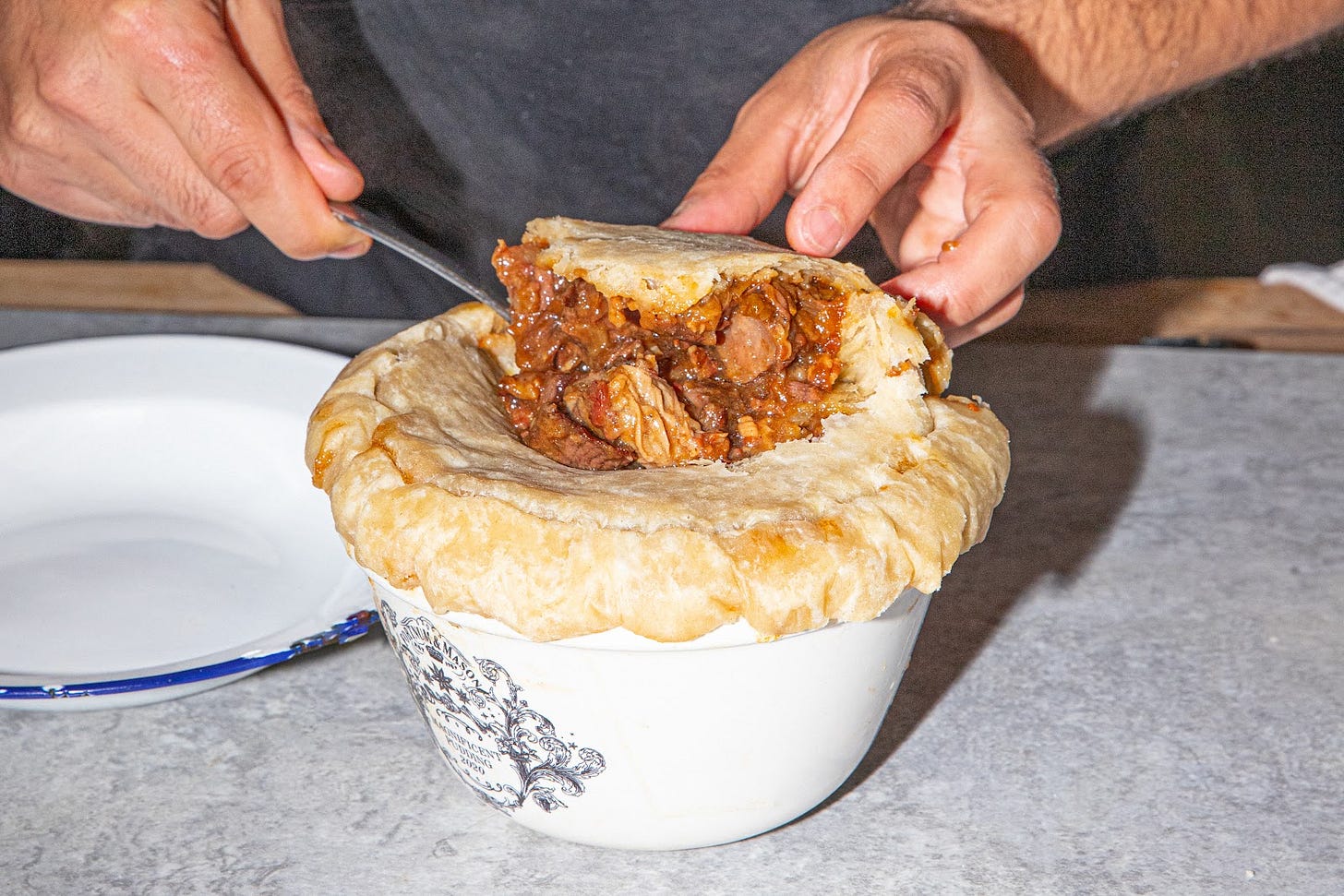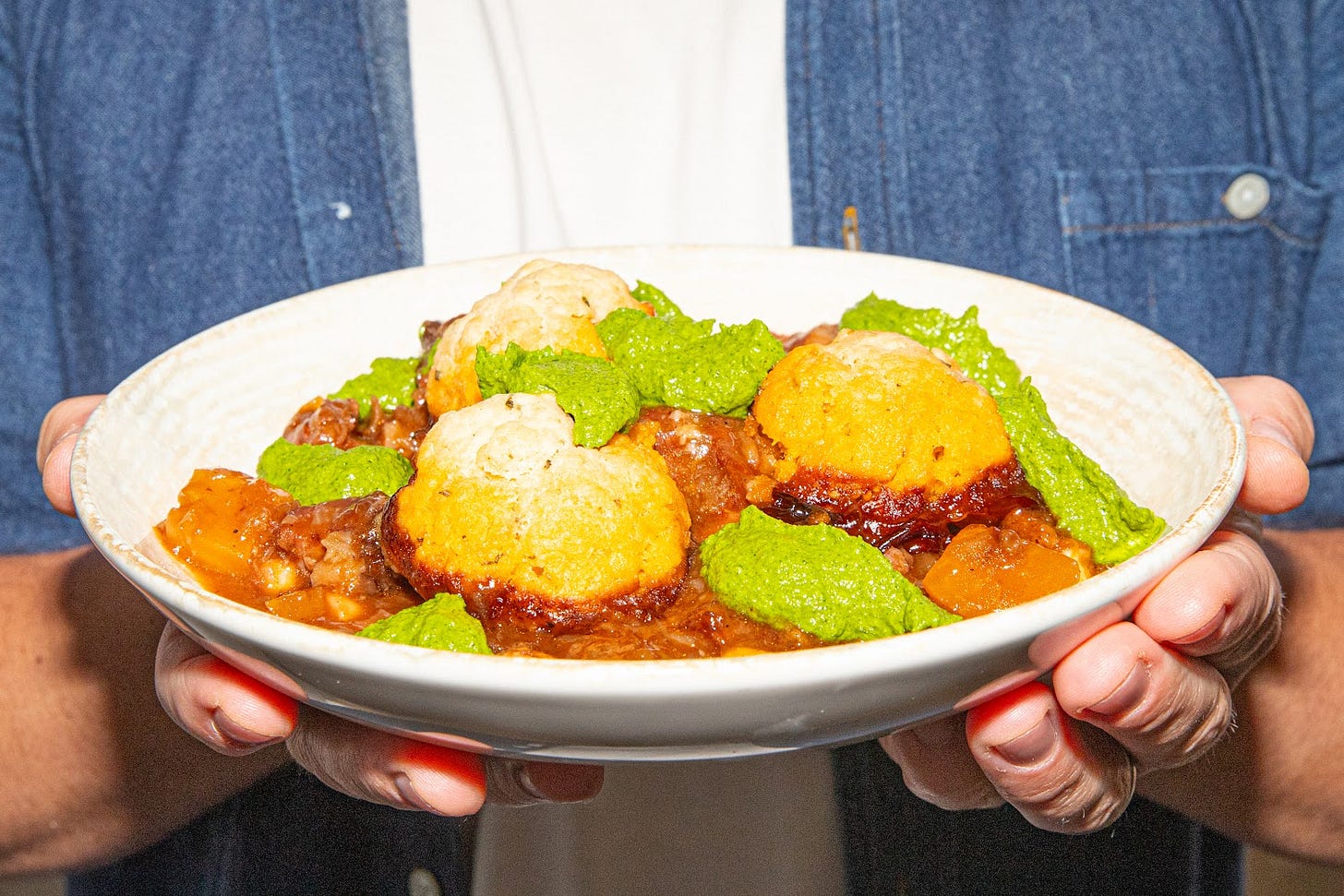011 - Comfort, Pie and Mash
A visit to a London institution, comfort food and 3 wonderfully stodgy recipes.
Hello and thanks for opening this month’s Food Team newsletter! Comfort is well and truly on the menu now the weather has started to get a little cooler over the past couple of weeks. We headed down to one of London’s few remaining Pie and Mash shops this month with Elliza for an education on all-things pastry and liquor. Scroll down a little further for 3 recipes that use suet to warm and soothe.
Slater: I have worked with Elliza for just over 3 years. You might not have seen her on camera before, but if you have bought anything from Sorted over the past few years, she probably had something to do with it. Jumpers, tea towels, books, courses and live show tickets have all started their life in her mind and made their way onto our website through hours of research, testing and re-testing. However, impressive though it is, we had very little interest in her expertise in e-commerce for the purposes of this newsletter. We wanted to know all about Pie and Mash shops, or rather “Pie Mash shops” (as she hastily corrected me) for a British comfort food deep dive. A childhood spent in Depford’s branch of M. Manzes qualified her well to be our unofficial guide!
“Pie Mash” shops have played an integral role in London’s food scene for over 200 years and are generally found towards the East of the city. In the 19th century, air pollution was even worse than it is today. The wind would generally blow smog towards the coast, meaning the working classes presided in the East while the upper classes settled in the West. Clean air carried, and still carries a premium in London. The working classes needed feeding as many lacked the resources to cook at home. Pies were cheap to make, and could be filled with all manner of mystery meats - as evidenced in the tale of Sweeny Todd, a barber who would murder his clients and repurpose them into pie fillings. While this quite grizzly tale is purely fictional, it does point to public opinion of pie shops in 1846 and what they may or may not have bulked their meat pies out with.
Two years before Rhymer and Prest were writing about mystery meats and demon barbers, London’s first Pie Shop opened, serving shallow pies, mashed potatoes… and eels; lots of eels owing to the fact that they were one of the only animals strong enough to survive in the heavily polluted Thames. While the working classes were suffering the effects of poor air quality, the native fish population had been wiped out in the city’s rivers. Eels are still served today in Pie Mash shops in jellied form - a textural experience that I had managed to avoid until Elliza convinced me that it was an important part of our trip to a Pie Mash shop a short walk from the studio.
It’s quite easy to make a tit of yourself in a Pie Mash shop if you don’t have much experience - something I became very aware of as Elliza effortlessly ordered “one pie double mash”. It’s also important to manage your expectations slightly. You won’t find spoon-tender meat, flakey pastry and deep rich gravy here. For that, frequent one of the hundreds of soulless gastro pubs lining the Thames. Manze’s is a white and green tile-clad temple to filling, in-offensive food that nourishes the soul. The artfully smeared mash is under-seasoned, but it doesn’t matter, they provide massive salt and pepper shakers on every table. The pies are a little one dimensional, but the pros smother them in chilli vinegar for a bit of lift. Elliza stabbed hers with haste, creating pockets for the vinegar to flow into.
Aiden, who joined us for the excursion from the office, was a relative newcomer to London. He looked up from his first ever plate of Pie Mash and asked what the liquor “actually was”. A question neither Elliza or I knew how to answer. Parsley and stock definitely had something to do with it at some point, but from what I could ascertain, it was simply a vessel for sharp vinegar and a softener for the firm mash. Functional food at its most delicious - he drew parallels between his Pie Mash lunch and a stew called Coddle from back home. The Irish started boiling leftover sausages and potatoes together to make a warming stew around the same time that the industrial revolution was pushing Londoner’s into new fangled Pie and Mash shops.
On the way back to the studio, Elliza and I discussed comfort food, and what constitutes comfort. While I was comforted by the pastry, mince meat fillings, soft mash and runny liquor, for Elliza it was a little deeper. For her, and many others born and bred in London, Pie Mash shops offer an experience to reconnect with their childhood and generations that have come before them. A chance to sit in the same seats, taste the same tastes and hear the same sounds in a place that has barely changed since their fathers, fathers, father first ordered double pie, double mash and a healthy scoop of eels.
I find it hard to think about British comfort food without thinking about suet (shredded beef fat, often used in place of butter or oil in our domestic culinary canon). The following recipes make the most of this unique ingredient, shedding light on some simple, unapologetic, and wonderfully stodgy national classics, perfect for the coming months.
Short Rib, Ale and Oyster Suet Pudding
Serves 4
It’s probably worth noting that this pudding isn’t what you might expect a pudding to be, especially if you are not from the UK or were born after 1970 (scroll down a little further for one of them!). Britain boasts little in the way of food history, but we do have puddings. Large filled or unfilled balls of suet pastry, that used to be bound with muslin and boiled. It was only in the mid 17th century after our pottery industry really took off that people started steaming them in bowls, providing them with a shape that is characteristic of a good ol’ English pudding today.
For the filling
3 tbsp vegetable oil
500g boneless beef short rib, roughly diced
2 tbsp plain flour
2 onions, peeled and roughly diced
2 bay leaves
8 rashers smoked streaky bacon, diced
500ml brown ale
12 oysters, shucked, juice reserved
300ml good beef stock
For the suet pastry
300g strong bread flour
1 tsp baking powder
150g shredded beef suet
Preheat the oven to 150°C.
Heat the oil in a large, oven proof pot over a high heat. Toss the beef with the flour and a generous pinch of salt to coat the chunks fully while the oil comes up to temperature. Once the oil starts to shimmer and loosen, tip in the beef and fry until golden on all sides - you may have to do this in 2 batches.
Transfer the beef to a plate, reduce the heat to medium, then tip the onion, bacon and bay leaves into the pan. Fry for a further 6-8 minutes, until browned all over. Add the ale, deglaze and reduce by ½. Add the beef back into the pan, along with the juice (liquor) from the oysters, the stock and enough water to just cover everything if necessary.
Whack the pan into the oven and braise uncovered for 3-4 hours, until the beef is spoon tender.
While the beef braises, add the flour, baking powder, suet and a generous pinch of salt to a bowl. Add 200ml of ice cold water to the bowl, then bring everything together with a butter knife.
Knead the dough a little on a clean work surface, then split it into two balls - one double the size of the other. Wrap the balls in cling film and chill in the fridge until needed.
Once the beef is tender, remove it from the pan into a large mixing bowl with a slotted spoon and reduce the liquid in the pan over a high heat, until thick and gravy-like.
Liberally grease a pudding bowl with butter while you wait and line the bottom with a small disc of greaseproof paper.
Roll the balls of dough out to a 1cm thickness on a lightly floured work surface - line the greased pudding bowl with the larger of the two halves. It doesn’t matter if it folds in on itself in a couple of places.
Drizzle around 150ml of the reduced gravy over the reserved meat, add the oysters, then using a spoon beat everything a little to break the meat up a bit and get everything coated. Taste and adjust the seasoning. We will use the rest of the gravy later.
Load the beef mix into the pastry-lined pudding bowl and push it down a little to prevent any pockets of air forming. Wet the edges of the pastry and lay the smaller disc on top. To seal the pudding, crimp the pastry discs together all round the rim of the pudding bowl, trim the excess pastry to neaten things up a little.
Lay a sheet of greaseproof paper over the pudding, then a double layer of tin foil over that. Lay a dish cloth over that, then secure everything with string wrapped around the circumference of the pudding bowl near the top.
Steam the pudding for around 2 hours, until the pastry sets fully. We used our steamer oven for this, but in the (likely) event that you don’t have one of these… Place a small upturned heatproof plate or tart mould into a very large pot and tip in enough water to come 4-5cm up the sides of the pot. Balance the pudding bowl on the saucer, cover with the lid and place the pan over a medium/low heat to steam.
Once the pudding is ready, leave it to rest for 10 minutes, then spoon it out onto a plate. Serve with the remaining gravy.
Lamb Stew with Rosemary Dumplings and Mint Sauce
Serves 4-6
This recipe is really three recipes in one, which all work amazingly well together or can be used in a variety of different ways. Try using the dumpling mix as a quick sausage casserole topper or folding the mint sauce through couscous after you have mastered them in this recipe.
For the stew
600g lamb shoulder, boneless
2 tbsp plain flour
3 tbsp vegetable oil
2 brown onions, peeled and roughly diced
1 head garlic, cut in half
1 tbsp tomato paste
187ml red wine
500ml good beef stock
1 large swede, peeled and roughly diced
For the dumplings
150g self raising flour
2 sprigs fresh rosemary, finely chopped
75g shredded beef suet
Ice-cold water
For the sauce
2 large bunches mint, leaves
2 tsp citric acid
2 tbsp vinegar
4 tbsp olive oil
100g pitted green olives
50g anchovies, drained
Preheat the oven to 150°C.
Cut the lamb shoulder into large chunks, around 3cm by 3cm. Toss with the flour and a generous pinch of salt on the board to coat them fully.
Heat the oil in a large, ovenproof pot you have a lid for over a high heat. Once the oil begins to shimmer and loosen, tip in the lamb and fry until golden on all sides - you may have to do this in 2 or 3 batches.
Transfer the lamb to a plate, reduce the heat to medium, then tip the onions and garlic into the pan. Fry for a further 6-8 minutes, until browned and caramelised in places. Add the tomato paste, fry until sticky, then deglaze with the wine and reduce by ½.
Tip the lamb back in, add the stock and a little more water if necessary to cover. Bring everything up to a boil over a medium heat.
Season lightly with salt, pop a lid on the pan, then braise in the oven for around 2 hours, until the meat is nearly tender and the liquid has thickened slightly. Add the swede after 1 hour of braising and remove the lid from the pan.
When the meat has had 2 hours in the oven, rub the four and rosemary together in a large mixing bowl with a generous pinch of salt (this will release some more of the rosemary’s flavour). Add the suet, 6 tbsp of ice-cold water and bring everything together using a butter knife.
Quickly work the dumpling mix into 8 balls, making sure not to over-work it – as this will make the dumplings too heavy.
Take the pan from the oven, top with the dumplings and replace the lid. Braise for a further 20 minutes, before removing the lid and cooking everything in the oven for a final 30 minutes, until the dumplings start to become golden on top and the lamb is completely tender.
While the dumplings cook, bring a large pot of water up to a boil. Add the citric acid and allow it to dissolve - this will stop the mint from browning later.
Add the mint, let the leaves darken and wilt for around 30 seconds, then plunge into ice water.
Squeeze any moisture from the mint leaves, then add them to the jug of a high-powered blender along with the vinegar, oil, olives and anchovies. Bitz until smooth and vibrant green, loosen with a splash more oil if necessary. Season to taste with salt.
Once the stew and dumplings are ready, drizzle over the mint sauce, take the pan to the table and tuck in.
No Frills Suet Sticky Toffee Pudding
Makes 8 portions
Sticky toffee pudding is a bonafide British classic served everywhere in the UK from schools through to classy gastro pubs once the nights start to draw in. For this recipe, we wanted to create a sponge that didn’t need to be eaten right away, in fact, it's best to allow this sponge to cool before reheating with sauce whenever you get the craving, or have to feed a crowd.
For the sponge
1 tsp vanilla paste
190g dates, roughly chopped
½ tsp bicarbonate of soda
Butter, for greasing
60g shredded beef suet
80g light brown sugar
100g muscovado sugar
2 medium eggs, beaten
240g self raising flour
1 tsp baking powder
¼ tsp sea salt
For the sauce
200g muscovado sugar
75g unsalted butter
250ml double cream
2 tbsp dark treacle
To serve
Vanilla ice cream
Add 280ml of water, the vanilla and dates to a medium saucepan and place over a high heat. Bring everything up to a bubble, then take the pan off the heat. Stir in the bicarbonate of soda and leave to cool slightly.
Preheat the oven to 180°C and grease a 22-30cm (approx) rectangular cake tin liberally with butter. Line the bottom of the tray with greaseproof paper.
Add the slightly cooled date mix to a food processor, and blitz until smooth. Add the suet, sugars and blitz again, slowly add the beaten eggs, blitzing all the while.
Add the flour, baking powder and salt, then pulse everything together, scraping down the sides of the food processor with a rubber spatula after each pulse.
Tip the mix into the lined tray and spread it out to form an even layer. Cover the tray tightly with tin foil.
Bake in the oven for 20-25 minutes, until risen and bouncy to the touch, when a skewer is inserted into the centre, it should come out clean.
To make the sauce, add the sugar, butter and double cream to a medium saucepan and place it over a medium heat. Allow everything to melt, then add the treacle. Simmer the sauce for a further 6-8 minutes, until dark and sticky.
Once the sponge is ready, allow it to cool completely, then cut it into squares.
When you are ready to serve, add the sponge to bowls, top with a few spoonfuls of the sauce and microwave on full power for 1-2 minutes, until piping hot.
Serve with plenty of ice cream.









Great read as always folks :)
FTM! We though this one might be right up your alley! https://tinyurl.com/493x7thb ✡️🍏🍷